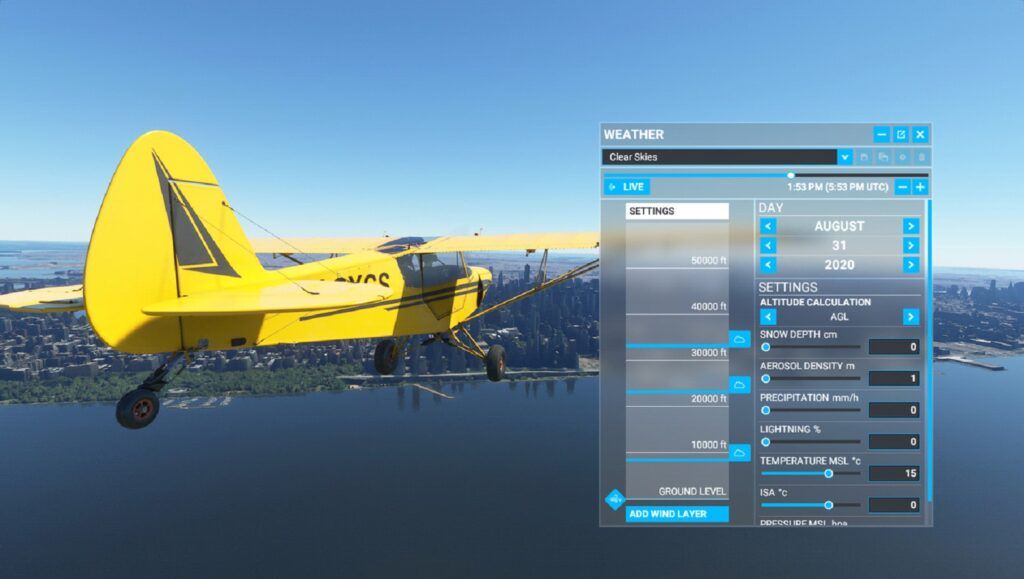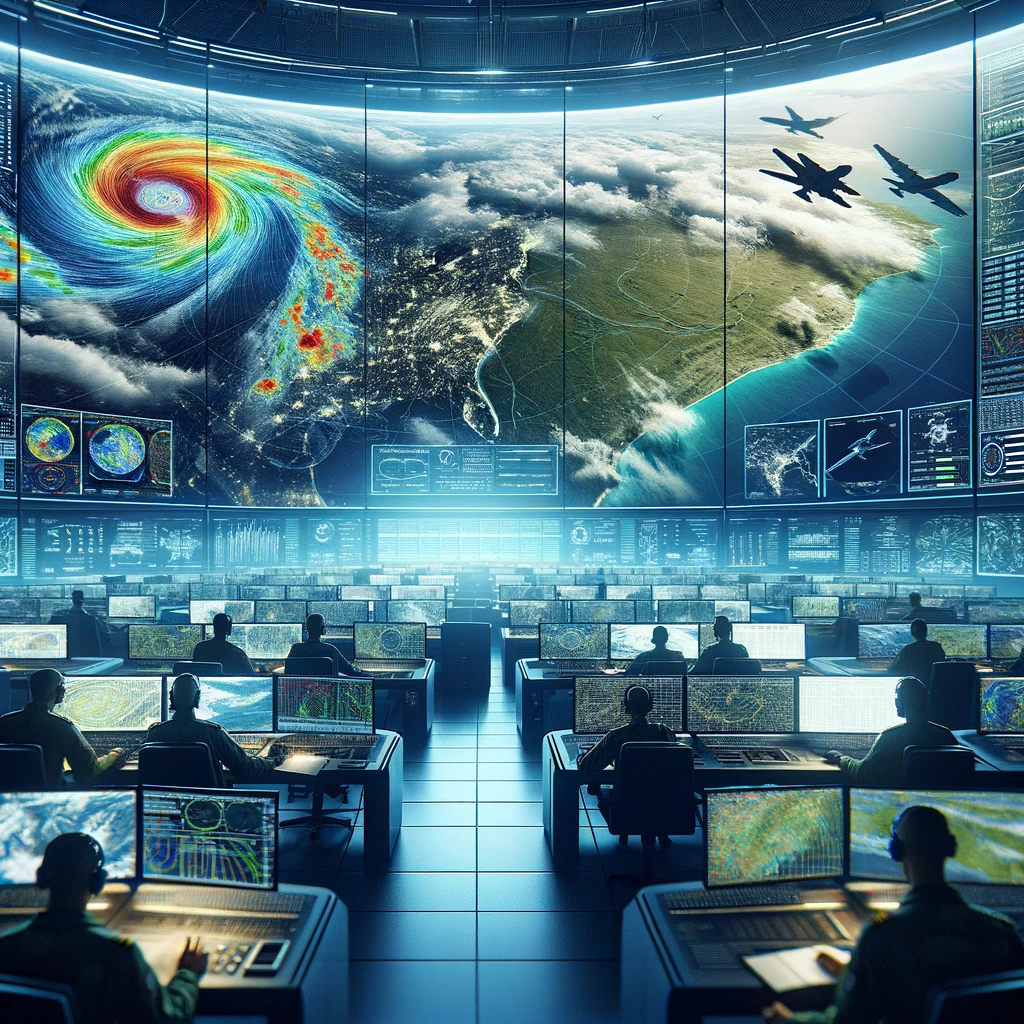Microsoft Flight Simulator Weather -Training Benefits of Weather Variation:

Imagine piloting a Cessna or other aircraft through a crisp morning sky, with every detail from the wispy cirrus clouds to the warm hues of dawn meticulously crafted to mirror real-life aviation conditions. This level of detail is a cornerstone of Microsoft Flight Simulator’s reputation among enthusiasts and professionals alike. The simulator’s weather system doesn’t simply paint a pretty picture; it shapes the very essence of each flight, challenging pilots to adapt to ever-changing conditions.
At its core, the simulation of weather in Microsoft Flight Simulator is about immersion. It’s about pushing the boundaries of what’s possible in a virtual environment. As pilots navigate through this digital atmosphere, they contend with a host fantastic yet familiar meteorological phenomena. Gusts of wind, pressure changes, and varied visibility are more than mere backdrop; they’re integral, active elements in the flying experience, teaching players the unpredictability of flying.
Progress in technology has brought us to a point where virtual clouds are no longer static backdrops but dynamic, evolving systems. Microsoft Flight Simulator achieves this realism by employing sophisticated algorithms that replicate real-world weather patterns. By doing so, they present enthusiasts with a platform that’s not just entertaining but also profoundly educational.
And it’s not just about what you’ll see out of the cockpit. Every element of the weather in Microsoft Flight Simulator affects aircraft performance and handling. Pilots are compelled to understand and react to these conditions whether they’re in it for an authentic flying experience or sharpening their skills for real-world aviation.
With an understanding of the foundational role weather plays in Microsoft Flight Simulator, we can transition to breaking down its functionality. This analysis will reveal how this advanced simulation interprets and projects real-time weather data into the virtual skies, providing an experience that is as unpredictable as it is captivating.
The Real-Time Meteorological Marvel: How Dynamic Weather Transforms Your Flying Experience:

You might not feel the wind on your face or the drop in temperature as a storm approaches, but in Microsoft Flight Simulator, the dynamic weather system brings these elements to life in your virtual cockpit. The game revolutionizes flight simulation by integrating real-world weather data, allowing you to experience the atmosphere exactly as it is, anywhere on the planet, at any given moment.
Imagine you’re planning a flight from New York to London. As you prepare for departure, you check the weather and find out there’s a massive thunderstorm brewing over the Atlantic. This isn’t just a pre-programmed scenario; it’s the actual weather happening in real time. The integration of live weather data means that if it’s raining in Paris right now, it’s also raining in your simulation over Paris.
How does this affect your flying experience? From a gentle breeze that nudges your aircraft to the fierce gusts that demand your utmost attention, dynamic weather conditions require you to be adaptable and strategic. You’ll decide whether to reroute around that storm or delay your flight, just as real pilots do.
Besides the thrill and challenge, the impeccable weather simulation serves a greater purpose: education. Students and aviation enthusiasts can learn a great deal about weather patterns, cloud types, and the significant role weather plays in aviation. More than a game, Microsoft Flight Simulator is a tool that shapes better, more weather-aware pilots.
Customizing the Clouds: A Guide to Adjusting Weather Settings in Microsoft Flight Simulator:

I understand the thrill of testing one’s skills against the unpredictable forces of nature. That’s why tweaking the weather settings in Microsoft Flight Simulator can add layers of challenge and enjoyment to the simulation experience. Here’s a straightforward guide to customizing weather conditions to suit your preferences or training requirements.
When you first open the Weather Settings panel, you’ll see a range of options for creating a diverse array of meteorological environments. If you’re just starting, you might want to simplify the settings, opting for clear skies and minimal wind to focus solely on handling the aircraft. As you gain confidence, introducing variables like fog, crosswinds, or rain can help you develop your pilot skills under less than ideal conditions.
If you’re ready to push your abilities to the limit, tweaking the settings can simulate extreme weather. Setting up scenarios with strong wind gusts, severe icing, or even thunderstorms will test your understanding of in-flight aerodynamics and your aircraft’s capabilities. Just a warning: make sure you’re prepared for a challenge!
For those who prefer a structured approach to training or are instructing others, Microsoft Flight Simulator offers a selection of preset weather themes. These are ideal for setting up standardized scenarios that can be replicated time and again, ensuring consistency in the training environment.
Creating custom weather conditions isn’t just about challenge and realism; it’s also a unique learning opportunity. By simulating various weather states, you’ll understand the effects of atmospheric changes on flight dynamics and develop new strategies for dealing with unexpected weather changes after taking off.
Customizing the Clouds: A Guide to Adjusting Weather Settings in Microsoft Flight Simulator:
Microsoft Flight Simulator empowers you to tailor the skies to your preferences or training needs. Whether you aim to enjoy a leisurely flight through calm skies or test your piloting skills against the fiercest storms, the game’s weather engine has you covered. In this section, I’m going to walk you through adjusting these settings to create your ideal flight experience.
First up is accessing the Weather menu. This is your control panel for everything related to the virtual skies. You’ll find options ranging from cloud density and type to the precise timing of weather changes. It’s all there to tinker with until the conditions are just right.
Perhaps you’re a beginner? Start with milder weather to get a handle on the aircraft without extra pressure. Increase the complexity as you gain confidence—add a bit of wind, some light rain, or even a soft blanket of fog. This incremental advance helps you build skills without becoming overwhelmed.
Experienced pilots can conjure up a storm—quite literally. Microsoft Flight Simulator allows you to simulate severe weather events. Think about setting up a thunderstorm complete with lightning and gusty winds, or a blizzard that reduces visibility to almost zero. It’s your chance to understand and respect the power of nature from the safety of your home.
Do you have specific scenarios in mind? The simulator’s presets offer quick access to a variety to conditions. From severe weather challenges to clear, balmy days perfect for sightseeing, you can select a scenario that fits your current desire or training goal.
Beyond the thrill or the educational value, adjusting weather also has a practical advantage. It prepares you for real-world flying conditions. By gradually facing more complex weather scenarios, you’re not just playing a game—you’re developing vital skills that could translate to real-life aviation knowledge.
Soaring Beyond the Simulation: The Real-world Applications of Microsoft Flight Simulator Weather:
I’ve explored how Microsoft Flight Simulator’s weather system not only impresses in the realm of virtual aviation but also prepares enthusiasts for real-world flying. With its advanced simulation capabilities, users gain valuable insights into meteorology and develop a keener understanding of its critical role in aviation.
Pilots, both seasoned and novice, benefit immensely from this technology. The software serves as a risk-free training ground, where they can experience and react to harsh weather without real-life consequences. Students of aviation can observe and understand weather patterns, which is foundational for their future careers.
Educational institutions might use the simulator as an illustrative tool, providing a practical dimension to theoretical meteorological concepts. By simulating real-world weather phenomena, Microsoft Flight Simulator bridges the gap between academic knowledge and hands-on experience.
For hobbyists, it’s a thrilling way to engage with flying, gaining an appreciation for the complexities and beauty of piloting an aircraft through various weather conditions. This marvel of technology not only entertains but also educates, making it a valuable tool for anyone fascinated by the skies.
In conclusion, Microsoft Flight Simulator’s weather system is much more than a feature for realism—it’s a platform for education and a testimony to the significance of weather in aviation. Its seamless blend of entertainment and learning paves the way for innovative uses beyond the screen, impacting the real world of flying in remarkable ways.



So I could get this in addition to the Fiight Simulator 2020? Or would this be a simulator as well, just with weather features? I like this a lot. My dad is in Alaska, and the weather there is always changing. So knowing how to fly in different weather conditions would be very helpful for sure. He is going to be amazed when I visit the next time!
Yes you can select any kind of weather in Flight Simulator and you can even change the weather while flying.
Hi MElamin,
Wow! this is so interesting when I see that you can change the weather, etc… – What I love is the capabilities the simulator has. Just imagine you can change the weather to think as if it is real. Of course, that is a virtual world. However, this article has kicked my thinking about this simulator.
Thanks – Great job!
Thanks for the feedback. You can also activate real weather in Flight Simulator 2020.
I’m glad I came across your page! I absolutely love planes and helicopters, if I could have the chance to get behind one I would love to fly it!
But this is great, it’s the next best think to flying one, I have heard of this simulator a few times however hadn’t the chance to check it out but after having a sneak peek of what it’s about I’m definitely going to check it out! I love the ability to choose whatever weathers, it’s a great simulation!
Thanks for the feedback.